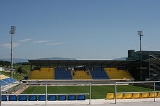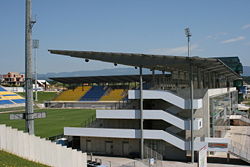
Arena Petrol
Encyclopedia

Football (soccer)
Association football, more commonly known as football or soccer, is a sport played between two teams of eleven players with a spherical ball...
stadium
Stadium
A modern stadium is a place or venue for outdoor sports, concerts, or other events and consists of a field or stage either partly or completely surrounded by a structure designed to allow spectators to stand or sit and view the event.)Pausanias noted that for about half a century the only event...
in Celje
Celje
Celje is a typical Central European town and the third largest town in Slovenia. It is a regional center of Lower Styria and the administrative seat of the Urban Municipality of Celje . The town of Celje is located under Upper Celje Castle at the confluence of the Savinja, Ložnica, and Voglajna...
, Slovenia
Slovenia
Slovenia , officially the Republic of Slovenia , is a country in Central and Southeastern Europe touching the Alps and bordering the Mediterranean. Slovenia borders Italy to the west, Croatia to the south and east, Hungary to the northeast, and Austria to the north, and also has a small portion of...
. It is the home ground of NK Celje and was also the home ground for Slovenian national football team
Slovenia national football team
The Slovenia national football team is the national football team of Slovenia and is controlled by the Football Association of Slovenia. The team played their first match in 1992 after the split of Yugoslavia in 1991....
for their international home matches from 2004 until 2008.
At the time of its opening Arena Petrol was the most modern football stadium in the country. It takes its name from its principal sponsor, the Slovenian oil company Petrol
Petrol d.d.
Petrol Group is a Slovenian oil distributing company one of the largest in Slovenia and the former Yugoslavia which has 435 petrol stations of which:*312 in Slovenia;*36 in Bosnia and Herzegovina;*76 in Croatia;*5 in Serbia*3 in Montenegro;...
. The stadium opened on 12 September 2003 with its single stand giving it a capacity of 3,600. Two additional stands were built in the following two years, which expanded the capacity of the stadium to 10,085. With the newly constructed north stand it has 13,006 seats as of 2011. The pitch in the stadium is 105 metres long and 68 metres wide and covered with natural grass
Grass
Grasses, or more technically graminoids, are monocotyledonous, usually herbaceous plants with narrow leaves growing from the base. They include the "true grasses", of the Poaceae family, as well as the sedges and the rushes . The true grasses include cereals, bamboo and the grasses of lawns ...
. The stadium also features a pitch heating system and floodlighting
Floodlights (sport)
Floodlights are broad-beamed, high-intensity artificial lights often used to illuminate outdoor playing fields while an outdoor sports event is being held during low-light conditions....
.
In 2004, the stadium replaced the Bežigrad Stadium as the venue for all competitive home matches of the Slovenian national football team. In 2003 it replaced former stadium of Celje Football Club at Skalna klet, which now serves as training facility for members of the first team, and team sometimes plays friendly match.
National team matches
{| {| class="wikitable"!Date
!Competition
!Country
!Result
!Attendance
|-
|31 March 2004 || Friendly|| || 0-1 || 2.300
|-
|4 September 2004 || 2006 FIFA World Cup Q
2006 FIFA World Cup qualification
A total of 197 teams entered the qualification process for the 2006 FIFA World Cup, competing for a total of 32 spots in the final tournament. Germany, as the host, qualified automatically, leaving 31 spots open for competition...
|| || 3-0 || 4.000
|-
|9 October 2004 || 2006 FIFA World Cup Q
2006 FIFA World Cup qualification
A total of 197 teams entered the qualification process for the 2006 FIFA World Cup, competing for a total of 32 spots in the final tournament. Germany, as the host, qualified automatically, leaving 31 spots open for competition...
|| || 1-0 || 9.250
|-
|9 February 2005 || Friendly || || 0-3 || 4.000
|-
|26 March 2005 || Friendly || || 0-1 || 9.200
|-
|30 March 2005 || 2006 FIFA World Cup Q
2006 FIFA World Cup qualification
A total of 197 teams entered the qualification process for the 2006 FIFA World Cup, competing for a total of 32 spots in the final tournament. Germany, as the host, qualified automatically, leaving 31 spots open for competition...
|| || 1-1 || 8.000
|-
|3 September 2005 || 2006 FIFA World Cup Q
2006 FIFA World Cup qualification
A total of 197 teams entered the qualification process for the 2006 FIFA World Cup, competing for a total of 32 spots in the final tournament. Germany, as the host, qualified automatically, leaving 31 spots open for competition...
|| || 2-3 || 10.055
|-
|12 October 2005 || 2006 FIFA World Cup Q
2006 FIFA World Cup qualification
A total of 197 teams entered the qualification process for the 2006 FIFA World Cup, competing for a total of 32 spots in the final tournament. Germany, as the host, qualified automatically, leaving 31 spots open for competition...
|| || 0-3 || 9.000
|-
|31 May 2006 || Friendly || || 3-1 || 2.500
|-
|15 August 2006 || Friendly || || 1-1 || 3.000
|-
|7 October 2006 || UEFA Euro 2008 Q || || 2-0 || 3.000
|-
|28 March 2007 || UEFA Euro 2008 Q || || 0-1 || 9.520
|-
|2 June 2007 || UEFA Euro 2008 Q || || 1-2 || 8.000
|-
|12 September 2007 || UEFA Euro 2008 Q || || 1-0 || 4.000
|-
|13 October 2007 || UEFA Euro 2008 Q || || 0-0 || 4.000
|-
|21 November 2007 || UEFA Euro 2008 Q || || 0-2 || 3.600
|}
External links
- Arena Petrol Arena Petrol on Football Stadiums of Slovenia Information on Arena Petrol at NK Celje website

